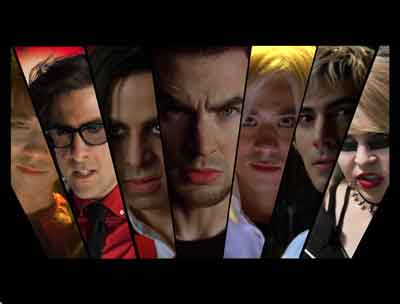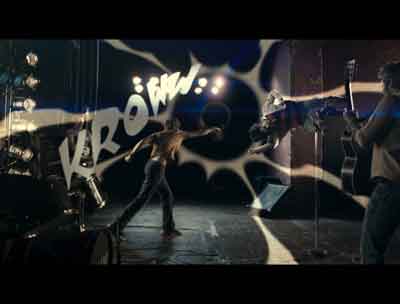Scott Pilgrim vs. The World Part 2

Scott Pilgrim vs. The World
Cast: Michael Cera, Mary Elizabeth WinsteadDirector: Edgar Wright
Genre: Action, Adventure, Comedy, Fantasy, Romance
Rated: PG
 Synopsis: Scott Pilgrim (Cera) has never had a problem getting a girlfriend. It's getting rid of them that proves difficult. From the girl who kicked his heart's ass-and now is back in town-to the teenage distraction he's trying to shake when Ramona (Winstead) rollerblades into his world, love hasn't been easy. He soon discovers, however, his new crush has the most unusual baggage of all: a nefarious league of exes control her love life and will do whatever it takes to eliminate him as a suitor.
Synopsis: Scott Pilgrim (Cera) has never had a problem getting a girlfriend. It's getting rid of them that proves difficult. From the girl who kicked his heart's ass-and now is back in town-to the teenage distraction he's trying to shake when Ramona (Winstead) rollerblades into his world, love hasn't been easy. He soon discovers, however, his new crush has the most unusual baggage of all: a nefarious league of exes control her love life and will do whatever it takes to eliminate him as a suitor.Release Date: August 12th, 2010
Marshmallowing Snow: Visual Effects
Instead of the typical, technical 3-D previsualsisation done for many films, the previz for Scott Pilgrim was created in homage to the graphic style of O'Malley's novels, with additional animated elements inserted to round it out. During the pitching phase of the project, a black-and-white animatic was designed to give the look and feel of the first fight, the one in which Scott Pilgrim faces off against Matthew Patel.
With panels taken straight from the pages of the books, Scott Pilgrim was designed by blending a mixture of references to Japanese anime and video games from multiple eras. This allowed for a concept piece that illustrated the energy Edgar Wright wanted for his live-action. Before the project was green-lit, this animatic became the basis for a live-action test to convince the studio the film was feasible.
As the project moved into full production, U.K.-based VFX company Double Negative-with additional work from Toronto-based digital studio MR. X-created similar animatics for the remaining fight sequences, performances and other parts of the film that would benefit from bringing the comics to life.
The majority of Mr. X's work involved cleanup and simplification of practical locations, as well as adding stylized snow.
Once preproduction began, the entire film was storyboarded by Oscar Wright in the style of the novels. Oscar Wright was responsible for crafting the film's concept art and graphics. Wherever possible, exact panels from the books were duplicated to set up shots, and then coverage was filled in to flesh them out for the film version. The visuals were always imagined by asking a simple question: Is this something that Bryan Lee O'Malley would have drawn?
Each day of shooting, the storyboards were distributed to the crew, who used the panels to compose the live-action shots. The production design and art direction were underpinned with the constant focus on graphic simplification in line with the comic artwork, which flowed through every element of the design-including sets, wardrobe and props.
Because of practical considerations, it wasn't always possible to maintain this look through the art department alone naturally, VFX became heavily involved? especially on location. Though the film is shot in Toronto, the teams had to extend a good deal of the location shots to achieve the hyper real look Edgar Wright wanted (e.g., as Scott and Ramona walk through snow to the swings). As it was impossible to blanket an entire street with perfect-looking snow in the middle of the summer, much of the team's work involved simplifying the look of practical locations and dressing them in the wintry style of the film.
For the VFX crews, the hero text graphics (once animated) became a favorite part of the production. On set, the teams would overlay a simple static graphic on the video-assist so shots could be composed. Once they were rendered, it was exciting to see memorable copy from Bryan Lee O'Malley's novels burned across the screen.
Approximately six months before preproduction began, production designer Marcus Rowland began prescouting locations. Because Bryan Lee O'Malley drew a fair number of his exterior panels while looking at the actual locations that inspired him (e.g., Wallace's apartment, Wychwood Library, Goodwill, Stephen Stills' place, Ramona's apartment, the house in which Scott grew up and Knives' high school), the team was fortunate enough to use the actual locales described in the books.
VFX team members accompanied Marcus Rowland and took still photographs that precisely matched the angle and composition of the panels in the books. From there, they put together a package that showed each of the locations with various levels of simplification-ranging from the photographs by themselves to looks that precisely matched Bryan Lee O'Malley's style. With Wright's guidance, the collaborators netted out visuals that landed somewhere in between the two styles.
The result became a mix of live action, with the details heavily reduced on screen. The team stopped before it began to make sets look too artificial?or as if they couldn't have photographed the scenes. For example, the VFX crew "pruned" trees and took off all but the thickest branches as they designed. They then dialed that look back for a few smaller saplings to make it look realistic. The treatment of the snow dressing was very specific and came from dozens of reference photographs of perfect, untouched, freshly fallen "marshmallow"-style lumps of powder. All traces of slush or granularity had to be cleaned up. On set, the rule was that they would have practical snow, or snow blankets, within 20 feet from camera and that everything past that point would be extended with VFX.
For the falling snow, the team developed a highly controllable and directable 3-D snow particle system. This could be fine-tuned for the amount of precipitate, speed of the snow and wind acting upon it, as well as for the character and the style of the weather pattern. Early in preproduction, the crew presented Wright with a range of possibilities for the "snow performance." The weather patterns were treated as if they were a character-going from a perfectly photo-real snow system all the way to a whimsical, artificial, cartoonish version inspired by panels in Bryan Lee O'Malley's books.
The filmmaker responded well to the various options, and Wright came upon the idea to use almost all of it-by changing the character of the snow when the mood called for it. This is especially apparent in the park scene in which the snow builds up from light wisps to a heavy whiteout?just as Scott and Ramona begin to fall for one another.
MORE





